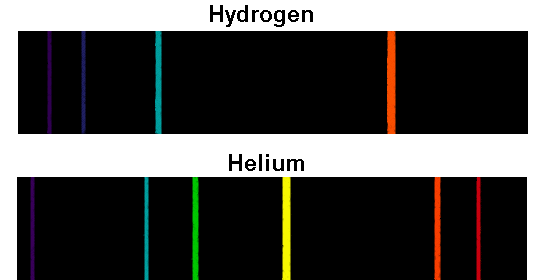

The wavelengths of the black lines in the bar of the “Absorption Spectrum” correspond to the wavelengths of colored lines in the bar of the “Emission Spectrum.” The wavelengths of the valleys in the graph of the “Absorption Spectrum” correspond to the wavelengths of colored lines in the peaks of the “Emission Spectrum” graph. The wavelengths of the valleys correspond to the five absorption lines in the spectrum bar above. The curve has the same concave-down shape as the “Continuous Spectrum,” but also includes five deep, narrow valleys. Arrows show that brightness increases upward and wavelength increases toward the right. The distance between lines increases from left to right.īelow the bar is a graph of “Brightness” on the vertical y-axis versus “Wavelength” on the horizontal x-axis. From left to right, the lines are in the dark purple, purple, blueish purple, blue, and yellow parts of the rainbow. Absorption SpectrumĪn arrow points down from light that has passed through the gas cloud to text that reads “Absorption Spectrum: Shows dark lines or gaps in light after the light passes through a gas.”īelow the text is a picture of an absorption spectrum in the form of a rainbow-colored rectangular bar with five thin black lines to represent absorption lines. The wavelengths of the peaks correspond to the five emission lines in the spectrum bar above. From left to right, the lines are dark purple, purple, blueish purple, blue, and yellow.


Emission SpectrumĪn arrow points down from the gas cloud to text that reads “Emission Spectrum: Shows colored lines of light emitted by glowing gas.”īelow the text is a picture of an emission spectrum in the form of a black rectangular bar with five thin colored lines to represent emission lines.

The curve is concave down, with a peak that aligns with the blue part of the rainbow bar above. A continuous curve is plotted on the graph. The “Wavelength” axis is aligned with the rainbow bar. From left to right, the colors are purple, blue, green, yellow, orange, and red.īelow the rainbow bar is a graph of “Brightness” on the vertical y-axis versus “Wavelength” on the horizontal x-axis. Continuous SpectrumĪn arrow points down from the continuous light source to text that reads “Continuous Spectrum: Spectrum that contains all wavelengths emitted by a hot, dense, light source.”īelow the text is a picture of a continuous spectrum in the form of a rainbow-colored rectangular bar. Three spectra shown in picture and graph forms are arranged horizontally, and are related to the elements of the illustration above. A set of six shorter, white wavy lines extends down from the cloud. On the far left is a white circle labeled “Continuous light source.” A solid wavy line labeled “light” extends to the right from the light source until it reaches a blueish irregular semi-transparent cloud-like form labeled “Cloud of gas.” The wavy line representing light is dashed after it enters the cloud and remains dashed to the right after it leaves the cloud. The bottom half shows the three types of spectra in picture and graph forms. The top half shows a light source, a light wave, and a cloud of gas. Infographic showing the relationship between the continuous spectrum of a star whose light is shining on gas, the emission spectrum of glowing gas, and the absorption spectrum of that gas.


 0 kommentar(er)
0 kommentar(er)
